The morning of Monday May 2, 2016 began like any other day. Patients at the Northern Lights Regional Health Care Centre (NLRHC) in Fort McMurray were attended to by their healthcare teams. Nutrition and Food Services staff prepared meals. Encroaching wildfires in the area had begun to cast a shadow – some neighbourhoods had already been evacuated, even patients of the Fort McMurray Recovery Centre south of the city – but nobody expected what was to come.
That morning, leadership at the hospital gathered to discuss emergency planning – just in case. They had been receiving regular updates on the blaze and wanted to be prepared for the worst. Even so, everything felt fairly normal.
“We all went home at the end of the day,” recalls Monique Janes, Patient Care Director. “Then on Tuesday things started to change.”
By noon on Tuesday the blaze had escalated, threatening new areas of the city. With more neighborhoods being placed under mandatory evacuations, and staff and patients hearing news over the radio, it was difficult for many to keep their minds on work.
“A lot of our nurses had internal struggles,” says Pam Lund, Emergency Department and ICU Manager. “They had children whose schools or daycares were being evacuated and their husbands were working at the plant sites an hour away or out fighting the fire.”
“I was feeling it myself, being a mother with my kids in school,” says Janes. “I made a call to my husband – I said, ‘you’ve got to get the kids out of school. Look after them. I can’t leave the hospital. I have way too much to do.’”
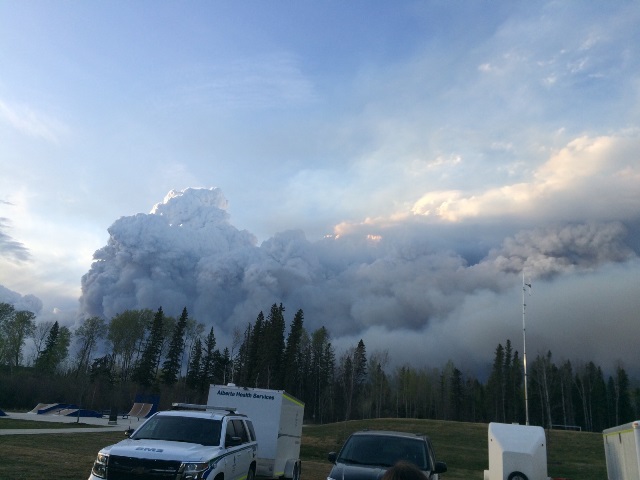
An AHS zone-wide Emergency Operations Centre (ZEOC) had already been set up, in constant communication with the municipality’s EOC.
“We knew events were progressing,” explains David Matear, Senior Operating Director at the NLRHC. “We anticipated that the situation could change very quickly and we wanted to get ahead of that in our decision making.”
The 30 wheelchair-bound continuing care clients on the fourth floor were one of the biggest concerns. Staff decided to bring them down to the main floor and look after them there, so a swift and comfortable exit could be made if necessary.
At about 5:00 p.m., the hospital began to evacuate, a wall of fire visible in the nearby ravine.
“We were trying to keep people calm,” says Janes. “When we got the mandatory evacuation, we were ready. We did it floor by floor.”
Patients began boarding buses and ambulances. One ventilated ICU patient required an air ambulance, which landed adjacent to the hospital.
Everyone remained amazingly calm and patient during the whole ordeal. “Not one person complained or cried,” says Lund. “There was no panic whatsoever. They trusted our staff and knew we were going to get them to where it was safe.”
Physicians and staff from all departments helped wherever they could. Nutrition and Food Services packed up food and water for the trip and unknown destination.
“We had so many people come together,” recalls Janes. “We had our facilities maintenance staff and our protective services guys loading crash carts and equipment – everything that we could need to run an emergency department. We didn’t know where we were going or how long we’d be there and what would be available.”
Meanwhile, the ZEOC, the North Zone Emergency Operations Centre, was working a few steps ahead of the on-the-ground staff to ensure care would continue after evacuation.
“Even though patients hadn’t been moved from the hospital yet, the ZEOC was looking into how and where our patients would be cared for when they eventually arrived in Edmonton. We were providing them with information on our patients and conditions and care needs, while planning our evacuation,” says Matear.
As planned, Lund was in one of the first ambulances to leave, along with some of the extra equipment. Other ambulances and buses followed, with Janes near the middle of the group.
“I could see the flames just across the street and up a bit and I could feel the heat,” Janes says, recalling the journey. Protective Services staff stayed behind to help sweep the building to ensure no one was left behind.
David Matear was the last of the hospital leadership and staff to leave the site, amidst the flames and thick black smoke. In total, 73 acute care patients and 32 continuing care clients were safely evacuated in less than two hours.
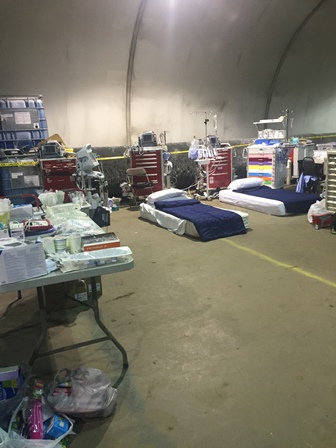
Once at Suncor’s Firebag site, an oilfield work camp 120 km northeast of Fort McMurray, physicians and staff worked around the clock to ensure patients received the care they needed.
Though the hospital had been evacuated, the task wasn’t finished. Now at the Firebag site, patients needed their care continued and also to be flown to points of safety.
Staff swiftly set up a triage area in an empty airplane hangar.
“We had new patients coming in who were having medical issues,” says Janes. “We were essentially running an emergency room in Firebag. We had people coming in who were sick with a variety of issues, including respiratory and cardiac problems, so we had to triage and medevac them as appropriate.”
Physicians and staff worked 24 to 36 hours straight to assess patients and get them on flights to the south during this second wave of evacuations.
A new group of doctors arrived to spell off the exhausted team that had handled the evacuation.
“At any one time there were between three and five 737s on the runway, and we had a couple dedicated medevac planes at our disposal,” adds Dr. Brian Dufresne, one of the relief team. “So I think all-in-all the transfer of critical patients was fairly quick and smooth.”
As all patients were evacuated from Firebag, it didn’t mean the need for health care in the community had ended. First responders were in the community, working hard in difficult circumstances. It was crucial to ensure there would still be ample health care available for them.
Initially a medical centre was set up in Gregoire, south of the city, for first responders, but this could not fully support the reentry into the city and hospital. To that end, a team of 10 AHS EMS staff flew in to Fort McMurray to join the team to create an Urgent Care Centre (UCC) in the city, using Portable Isolation Containment Systems (PICS.)
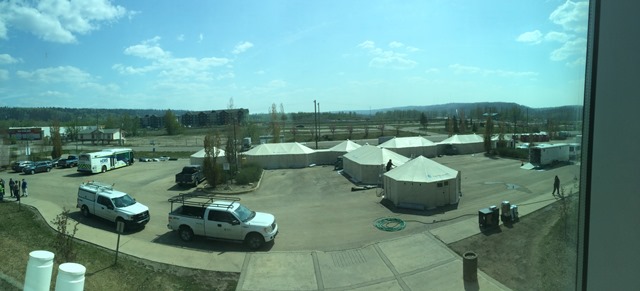
The PICS units are a series of portable, inter-connected, modular shelters allowing AHS to provide health care with clean air, clean water and significant space – all key factors that need to be addressed in a smoky environment without clean water.
“It was a huge task,” says Sam Primerano, AHS EMS Fleet Operations Team Lead, who headed up the operation. “We had a great team and everyone worked together and we were able to get that up in one and a half days which is, I think, unprecedented for something that large.”
The UCC included four 20 x 40 foot rectangular shelters, five 20 x 20 foot octagon shelters, and five vestibules to connect the shelters. It was supported with a HEPA filtered HVAC system, heating, air conditioning, a generator for power supply and interior lighting.
The structure included 30 patient spaces and was fully equipped to deal with significant urgent and emergent health issues – similar to the level of care and treatment one would expect from an emergency department. It even had an operating room.
The UCC opened May 14 and was taken down June 28. In the meantime, the NLRHC was filled with over 500 contracted workers and AHS staff members working in shifts around the clock to prepare the hospital for the return of residents to the city.
It hadn’t suffered any fire damage but there were significant issues caused by smoke and water.
“The biggest issue was the smoke caused by the fire and it was obvious when you walked into the hospital,” says David Ponich, AHS North Zone Director, FME. “Smoke made its way into the building leaving behind a strong smell and some residue, which compromised some of the hospital infrastructure and equipment.”
Water sprayed on the hospital’s roof to protect it during the peak of the fire had also caused some damage.
There was much to be done. Every ceiling tile in the facility (nearly 8,200 of them) was removed and replaced. The ventilation system was cleaned, water systems rigorously flushed out and both air and water quality tested regularly.
Carpets, linens, curtains, and towels were cleaned and others replaced. Several walls had to be re-painted. Hundreds of pieces of medical and lab equipment had to be cleaned, tested, and verified to ensure they were not affected by the smoke.
A team of electricians and plumbers went through the site room by room to ensure the plumbing and electrical systems are functioning properly.
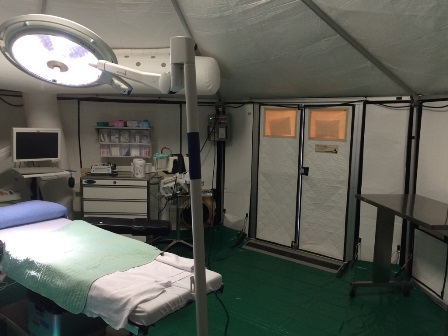
“It was quite the undertaking,” says Jimmy Aumont, Maintenance Manager, NLRHC. “You can imagine the coordination of having so many vendors and staff working on various projects throughout the building at all hours. It was a real team effort with our staff and our vendors.”
In addition, after all this work was completed, AHS Environmental Services, Infection prevention and Control and Workplace Health and Safety specialists had to approve the areas before clincal staff could begin restocking and organizing clinical areas to receive patients.
Those efforts allowed AHS to reopen the hospital’s Emergency Department on June 1 – the first day of public re-entry into Fort McMurray. Core services became available on June 13, most services operational by June 21 and then the entire facility by June 28.
Today the Northern Lights Regional Health Centre is again filled with activity and patients receiving the care they need.
While it might appear business-as-usual, as if the entire facility hadn’t evacuated with a wildfire at its heels months earlier, those involved haven’t forgotten.
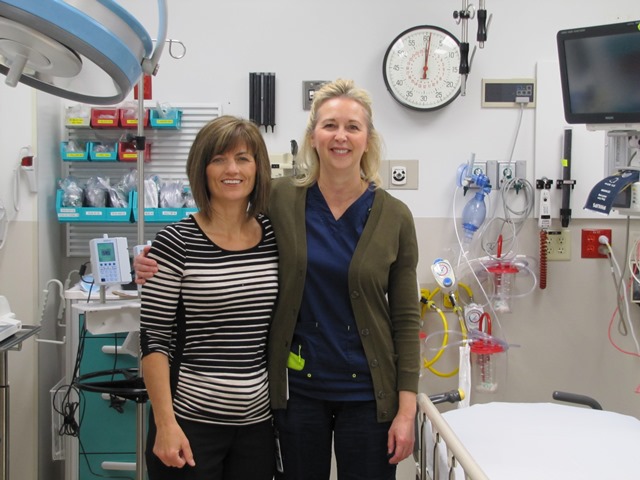
Emergency preparedness is always very important at a hospital but Matear says he can’t imagine how they would have practiced or drilled for what they experienced. “Just the scale of it, it’s so huge, it would be hard to prepare for.”
Normally an evacuation would involve just one part of the hospital, or perhaps the entire hospital to a nearby evacuation point, he says. Evacuating an entire hospital to an airplane hangar 120 kms away with a wildfire raging nearby was not something any of them had envisioned.
“We definitely know that emergencies can happen but I don’t think you could have imagined the scale of this event,” he says. “It was a monumental task and everybody worked extremely hard to make sure it went very, very smoothly.”
*With files from Sean Woods and Erika Dart



Comments are closed.